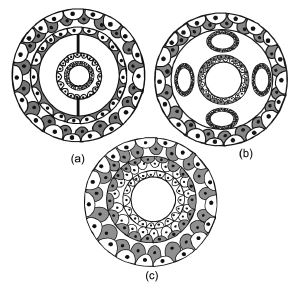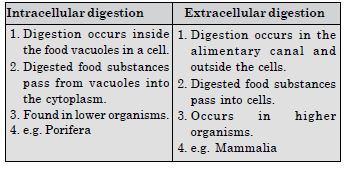Strengthen your performance for the exams with free NCERT Solutions available on the Aasoka platform. Designed by the experts, the content of the solutions is as per the latest CBSE syllabus and written in an easy-to-understand language that can easily be understood by students. The NCERT Solutions for Class 11 will make students exam-ready in no time. Prepare for exams with these solutions and achieve good scores.
The chapter “Animal Kingdom” of Biology Class 11 explains the different forms and structures of various animals, classification of animals, chordates up to class level and non-chordates up to phyla level; features of animals, and much more.
Question 1:
What are the difficulties you would face in classification of animals, if common fundamental features are not taken into account ?
Answer:
Common fundamental features like symmetry, germ layers, segmentation, coelom etc. provide a guide to classify animals on the basis of unique features which they possess. In the absence of such characteristics, the placing of animals in particular groups would be difficult and haphazard. Examples of convergent evolution, adaptive radiations, presence of vestigial organs etc. will provide problems for classification of animals. All animals placed under one group by taxonomists exhibit a variety of common fundamental features which make their recognition and description easy.
Question 2:
If you are given a specimen, what are the steps that you would follow to classify it ?
Answer:
- Finding out whether it is an animal or a plant.
If it is an animal, the following steps are followed further : - Study of level of organisation—cellular or tissue or organ or organ system level.
- Study of symmetry—Radial or bilateral symmetry.
- Presence or absence of body cavity and if present, it is pseudocoelom or eucoelom.
- Study of type of segmentation—internal or external metamerism.
Question 3:
How useful is the study of nature of body cavity and coelom in the classification of animals ?
Answer:
The presence or absence of a cavity between the body wall and the gut wall is very important in classification. The body cavity, which is lined by mesoderm is called coelom. Animals possessing coelom are called coelomates e.g., annelids, molluscs, arthropods, echinoderms, hemichordates and chordates.
In some animals, the body cavity is not lined by mesoderm, instead, the mesoderm is present as scattered pouches in between the ectoderm and endoderm. Such a body cavity is called pseudocoelom and the animals possessing them are called pseudocoelomates e.g., aschelminthes.
The animals in which the body cavity is absent are called acoelomates e.g., platyhelminthes.
Showing Coelom (a) Coelomate (b) Pseudocoelomate (c) Acoelomate
Question 4:
Distinguish between intracellular and extracellular digestion.
Answer:
Question 5:
What is the difference between direct and indirect development ?
Answer:
In many animals, the hatched organism resembles an adult, except that it is small in size and is often called a juvenile. The juvenile undergoes growth and sexual development only. Such a type of development is called direct development.
e.g. Ascaris, Pheretima, reptiles and birds.
In certain animals, the egg develops into a strikingly different organism from the adult that leads an independent free life and is called the larva. The larva undergoes drastic changes to form the adult by a process called metamorphosis. Such a kind of development is called indirect development.
Question 6:
What are the peculiar features that you find in parasitic platyhelminthes ?
Answer:
Features of parasitic platyhelminthes
- Presence of hooks and suckers.
- Platyhelminthes absorb nutrients from the host directly through their body surface.
- Digestive system is absent.
- Skeletal, respiratory and circulatory systems are absent.
- Well developed reproductive organs.
- Development is indirect with many larval stages.
Question 7:
What are the reasons that you could think of for the arthropods to constitute the largest group of animal kingdom ?
Answer:
Success of arthropods. It is largely due to their unique cuticle, segmentation and presence of jointed appendages. It is called arthropodization.
- The cuticle is composed of protein and the polysaccharide chitin. It may be strengthened by deposition of minerals (calcium phosphate and carbonate) in it. Being tough it protects the arthropods against pedators and forms jointed exoskeleton for muscle attachment. Being light, it does not add to body weight. Being impervious to water, it checks drying up of the body. It is termed sclerotization. This has enabled the arthropods to survive on land in almost any environment. The chitinous wings of the insects enable them to fly and cross barriers which other animals cannot cross.
- Striated muscles provide quick movements and tracheal respiration supplies energy rapidly.
- Groups (tagmata) of segments allow arrangement of organs.
- Jointed appendages have become specialized for a great variety of functions. This provides division of labour among the regions.
Question 8:
Water vascular system is the characteristic of which group of the following :
- Porifera
- Ctenophora
- Echinodermata
- Chordata.
Answer:
(c) Echinodermata.
Question 9:
‘‘All vertebrates are chordates but all chordates are not vertebrates.’’ Justify the statement.
Answer:
The chordates are characterized by the presence of a notochord at some stage of life cycle. Later this notochord may or may not get replaced by a cartilaginous or bony vertebral column. Those chordates in which the vertebral, column appears are called vertebrates and those chordates in which the vertebral column does not appear as protochordates. However they are chordates but not vertebrates. Thus all vertebrates are chordates but all chordates are not vertebrates.
Question 10:
How important is the presence of air bladder in Pisces ?
Answer:
1. The air bladder acts as a buoyancy regulator by altering the pressure in it. It enables the fish to stay at a particular depth without expending energy in swimming, thus conserving energy. 2. Air bladder also acts as an accessory respiratory organ.
Question 11:
What are the modifications that are observed in birds that help them to fly ?
Answer:
- The fore-limbs are modified into wings to provide a large surface area formed by the structures called feathers which are light in weight.
- The sternum is extended to form a keel. Large flight muscles are attached to the keel.
- Powerful flight muscles named pectorales majoris are present.
- The body is streamlined.
- Weight is kept to a minimum by the possession of a very light skeleton with hollow bones (pneumatic bones) and air sacs.
- The efficient flight is achieved by the birds taking advantage of vertical air movement i.e. by gliding and soaring.
- The coracoid bones are well developed transmit the ‘‘lift’’ of the wings to whole body.
- Brain is well developed.
- The metabolic rate of birds is relatively high to provide the energy required for flight.
- Urinary bladder is absent.
Question 12:
Could the number of eggs or young ones produced by an oviparous and viviparous mother be equal ? If so, why ? If not, how ?
Answer:
No. The number of eggs produced by oviparous animals is much higher than viviparous animals because the chances of fertilization and development are low. In viviparous animals the development of the embryo depends upon the mother ; so only one or few could be supported. In oviparous animals, some eggs may not get the favourable conditions for development and hatching and may degenerate. So a large number of eggs are produced.
Question 13:
Segmentation in the body is first observed in which of the following ?
- Platyhelminthes
- Aschelminthes
- Annelida
- Arthropoda.
Answer:
(c) Annelida.
Question 14:
Match the following
- Operculum
- Parapodia
- Scales
- Comb plates
Answer:
1. (d) 2. (c) 3. (b) 4. (a)
Question 15:
Prepare a list of some animals parasitic on human beings.
Answer:
Prepare a list of some animals parasitic on human beings.
- Itch-Mite
- Schistosoma
- Taenia
- Ascaris
- Hookworm
- Wuchereria
- Pinworm
- Trichinella
- Dracunculus
- Leech.


